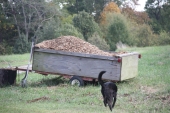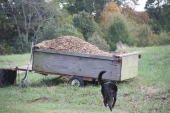

 2
2




Some places need to be wild










 1
1




Some places need to be wild
 1
1




Are you competing for the "understatement of the year award?" After what happened recently in Australia, and what has happened not many years ago in the interior of BC, I'm looking for easy ways to hold water in the soil, and keep the "small branches" under control as they feed the start of a fire much more than a large log on the ground does.I think a chipper would be a whole lot cheaper than a fire.
Yes, likely. That said it does depend on varieties - some "Delicatas" seem to be usable as a "summer squash" when young, but if allowed to mature, have a fairly tough shell that helps them keep much longer than some squash. Unfortunately squash is a hard sell at this house with the exception of pumpkin - in pie form! Luckily I have a fairly healthy recipe I can use for pumpkin pie.I bet that a mere 4 plants of summer squash will be plenty.
Visit Redhawk's soil series: https://permies.com/wiki/redhawk-soil
How permies.com works: https://permies.com/wiki/34193/permies-works-links-threads










 1
1




Some places need to be wild
 1
1




Visit Redhawk's soil series: https://permies.com/wiki/redhawk-soil
How permies.com works: https://permies.com/wiki/34193/permies-works-links-threads










 1
1




Some places need to be wild
 3
3




I'm suspicious that the "going yellow" part may have actually attracted the squash bugs - just like wolves looking for the sick or weak prey. I think you should put a post in the growies area describing the problem and how you've improved your soil. Something as simple as compost tea just before the risk period might be all you require to fix things, but you need people who would know your ecosystem/weather patterns etc. The yellow leaves make me think low nitrogen, but I may just think that because winter squash are heavy feeders, which is why the natives grew it with beans (although they were to help the corn also!)At that point the leaves would start to turn yellow and within about two weeks Squash bugs arrived in droves and the dark, green leaves got a whitish something growing on them
Visit Redhawk's soil series: https://permies.com/wiki/redhawk-soil
How permies.com works: https://permies.com/wiki/34193/permies-works-links-threads










 2
2




Some places need to be wild














Some places need to be wild










 4
4




Some places need to be wild










 2
2




Some places need to be wild
 2
2














 5
5




Some places need to be wild










 1
1




Some places need to be wild










 3
3




Some places need to be wild










 4
4




Some places need to be wild










 3
3




Some places need to be wild
 1
1




Fish heads fish heads roly poly fish heads
 2
2




I tried the tire thing years ago and it never worked and I've since read from several sources, that it didn't work for them either. I would just put down a 3 foot wide row of that lovely sounding material about 4 inches deep, put your spud starts down about a foot apart and cover with more material. Reserve a good pile of the material and add it as they need hilling. This should be better at conserving moisture which was part of the issue when I tried growing spuds vertically - it was just too hard to keep the moisture where I needed it. That said, if you've only got a tire-sized spot to try to grow in, you've not got much to loose.So, how do you think trying to grow some plants directly in those chips would do? I think I am going back to grab just enough chips to plant a "potato tire stack"
Visit Redhawk's soil series: https://permies.com/wiki/redhawk-soil
How permies.com works: https://permies.com/wiki/34193/permies-works-links-threads
 1
1




Fish heads fish heads roly poly fish heads










 2
2




Some places need to be wild










 2
2




Some places need to be wild










 2
2




Some places need to be wild
 4
4





Visit Redhawk's soil series: https://permies.com/wiki/redhawk-soil
How permies.com works: https://permies.com/wiki/34193/permies-works-links-threads














Some places need to be wild














 2
2




Some places need to be wild










 1
1




Some places need to be wild
 2
2


















Some places need to be wild
 1
1














 1
1




Some places need to be wild










 5
5




Some places need to be wild










 1
1




Some places need to be wild
 2
2














 1
1




Some places need to be wild










 1
1




Some places need to be wild










 2
2






Some places need to be wild
 3
3














 2
2




Some places need to be wild

|
It sure was nice of your sister to lend us her car. Let's show our appreciation by sharing this tiny ad:
The new gardening playing cards kickstarter is now live!
https://www.kickstarter.com/projects/paulwheaton/garden-cards
|








